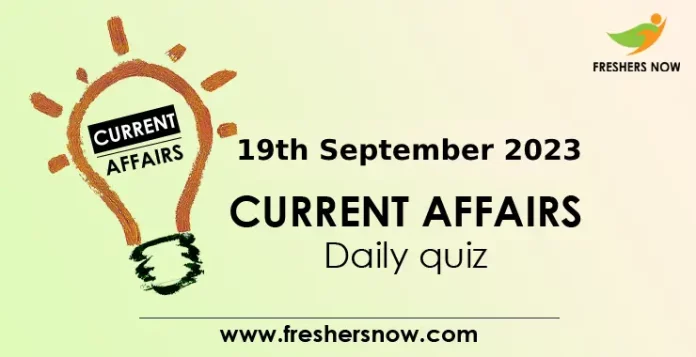
19th September 2023 Current Affairs Quiz: Greetings! Here are the Current Affairs Quiz for 19th September 2023! This quiz is meticulously crafted to evaluate your awareness of today’s significant and remarkable developments. It encompasses a diverse array of subjects, encompassing global affairs, sports, technology, and beyond. Stay well-informed and engage in this Current Affairs Quiz to assess your proficiency in staying updated with the latest occurrences worldwide on this day. Let’s dive in and gauge your grasp of current affairs. Best of luck!
19th September 2023 Current Affairs | Today GK Quiz
1. What is the enhanced gratuity limit for LIC agents as per the approved welfare measures?
A) Three lakh rupees
B) Five lakh rupees
C) Ten thousand rupees
D) One lakh fifty thousand rupees
Answer: B) Five lakh rupees
Explanation: The gratuity limit for LIC agents has been enhanced to five lakh rupees as per the approved welfare measures.
2. What is the eligibility criteria for reappointed agents to receive renewal commissions as per the approved measures?
A) They must have completed at least 5 years of service.
B) They must have a certain number of policy sales.
C) They must be affiliated with a specific LIC branch.
D) They must have a valid insurance license.
Answer: B) They must have a certain number of policy sales.
Explanation: Reappointed agents are eligible to receive renewal commissions based on their policy sales, as per the approved welfare measures.
3. Who has been named as the permanent CEO of Penguin Random House?
A) Markus Dohle
B) Stephen King
C) Nihar Malaviya
D) Arundhati Roy
Answer: C) Nihar Malaviya
Explanation: Nihar Malaviya has been named as the permanent CEO of Penguin Random House.
4. When was Penguin Random House formed through a merger?
A) 1998
B) 2001
C) 2013
D) 2023
Answer: C) 2013
Explanation: Penguin Random House was formed in 2013 through the merger of Penguin Group and Random House.
5. What is the primary objective of the ‘PM Vishwakarma’ scheme unveiled by Prime Minister Narendra Modi?
A) To provide free training to traditional craftsmen and artisans.
B) To offer low-interest loans without collateral to traditional craftsmen and artisans.
C) To establish vocational schools for artisans.
D) To provide monetary rewards to traditional craftsmen and artisans.
Answer: B) To offer low-interest loans without collateral to traditional craftsmen and artisans.
Explanation: The primary objective of the ‘PM Vishwakarma’ scheme is to provide low-interest loans without requiring collateral to traditional craftsmen and artisans.
6. How many families of traditional artisans and craftsmen are expected to benefit from the ‘PM Vishwakarma’ scheme?
A) Approximately 10 lakh families
B) Approximately 15 lakh families
C) Approximately 20 lakh families
D) Approximately 30 lakh families
Answer: D) Approximately 30 lakh families
Explanation: The ‘PM Vishwakarma’ scheme aims to benefit approximately 30 lakh families of traditional artisans and craftsmen, including weavers, goldsmiths, blacksmiths, laundry workers, and barbers.
7. What is the new name given to the old Parliament building in India?
A) Parliament House
B) Constitutional Legacy Building
C) Samvidhan Sadan
D) Heritage Parliament House
Answer: C) Samvidhan Sadan
Explanation: The old Parliament building in India has been renamed “Samvidhan Sadan” or “Constitution House.”
8. Why did Prime Minister Narendra Modi propose renaming the old Parliament building?
A) To erase its historical significance.
B) To modernize the building.
C) To honor India’s first Prime Minister, Jawaharlal Nehru, and preserve its legacy.
D) To connect future generations to the great leaders of India.
Answer: C) To honor India’s first Prime Minister, Jawaharlal Nehru, and preserve its legacy.
Explanation: Prime Minister Modi proposed renaming the old Parliament building to honor Jawaharlal Nehru and preserve its historical legacy for future generations.
9. What is the primary objective of the Scale Based Regulation (SBR) framework introduced by RBI for NBFCs?
A) To categorize NBFCs based on their age.
B) To categorize NBFCs based on their asset size and activities.
C) To categorize NBFCs based on their geographical location.
D) To categorize NBFCs based on their customer base.
Answer: B) To categorize NBFCs based on their asset size and activities.
Explanation: The SBR framework introduced by RBI for NBFCs aims to categorize them based on their asset size and activities to provide tailored regulatory oversight.
10. Which layer of the SBR includes NBFCs that warrant enhanced regulatory requirements based on specific parameters?
A) Base Layer (NBFC-BL)
B) Middle Layer (NBFC-ML)
C) Upper Layer (NBFC-UL)
D) Top Layer (NBFC-TL)
Answer: C) Upper Layer (NBFC-UL)
Explanation: The Upper Layer (NBFC-UL) includes NBFCs identified by RBI as warranting enhanced regulatory requirements based on specific parameters and scoring methodology.
★★ You Can Also Check ★★



